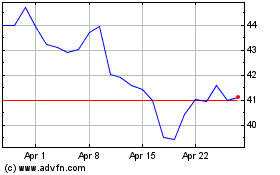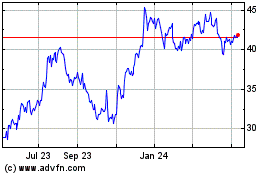Texas Bank Fails, Tally Hits 74 - Analyst Blog
October 03 2011 - 4:15AM
Zacks
Last Friday, U.S. regulators shuttered Plano, Texas-based First
International Bank, taking the number of failed banks thus far in
2011 to 74. This follows 157 bank failures in 2010, 140 in 2009 and
25 in 2008.
While the financials of a few large banks have been stabilizing
on the back of an economic recovery, the industry is still
struggling to survive. Nagging issues like rock-bottom home prices
along with still-high loan defaults and unemployment levels
continue to trouble such institutions.
Lingering effects of the financial crisis continue to weigh on
many banks. The obligation to absorb bad loans offered during the
credit explosion made these banks susceptible to severe
problems.
Further, according to a University of Michigan study released
earlier this month, the U.S. banks that were sheltered by
government bailout during the height of financial crisis took more
credit risk afterward. It’s obvious that these banks had taken such
a risky plunge to get higher and quicker returns to brush off the
bailout burden at the earliest.
But this repeated risk-taking ultimate resulted in further
threats to the system. Ultimately, risky loans and market
uncertainty aggravated the risk of bank failures even further.
First International Bank had total assets of about $239.9
million and total deposits of about $208.8 million as of June 30,
2011.
This failure represents another blow to the deposit insurance
fund (DIF), meant for protecting customer accounts.
The Federal Deposit Insurance Corporation (FDIC) insures
deposits in 7,513 banks and savings associations in the country as
well as promotes the safety and soundness of these institutions.
When a bank fails, the agency reimburses customer deposits of up to
$250,000 per account.
Though the FDIC has managed to increase its deposit insurance
fund over the last few quarters, the ongoing bank failures have
kept it under pressure. However, as of June 30, 2011, the fund
recovered to post a surplus of $3.9 billion, substantially better
than the deficit of $1.0 billion in the prior quarter. The positive
fund balance seen for the first time in two years was aided by a
moderate pace of bank failures and assessment revenue.
The failure of First International Bank is expected to deal a
blow of about $53.8 millionto the FDIC.
Houston, Texas-based American First National Bank has agreed to
assume the assets and deposits of First International
Bank.
The number of banks on FDIC’s list of problem institutions fell
sharply to 865 in the second quarter from 888 in the preceding
quarter. This represents the first sequential drop since 2006.
Increasing loan losses on commercial real estate could trigger
hundreds of bank failures in the coming years. However, considering
the failure trail so far this year, the FDIC does not expect the
number of bank failures in 2011 to exceed the 2010 tally.
With so many bank failures, consolidation has become the
industry fashion. For almost all the failed banks, the FDIC enters
into a purchase agreement with healthy institutions.
When Washington Mutual collapsed in 2008 (branded as the largest
bank failure in the U.S. history), it was acquired by
JPMorgan Chase & Co. (JPM). The other major
acquirers of failed institutions since 2008 include U.S.
Bancorp (USB) and BB&T Corporation
(BBT).
BB&T CORP (BBT): Free Stock Analysis Report
JPMORGAN CHASE (JPM): Free Stock Analysis Report
US BANCORP (USB): Free Stock Analysis Report
Zacks Investment Research
US Bancorp (NYSE:USB)
Historical Stock Chart
From May 2024 to Jun 2024

US Bancorp (NYSE:USB)
Historical Stock Chart
From Jun 2023 to Jun 2024
